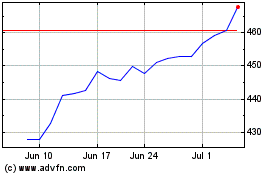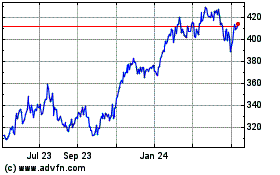Tech Firms Tweak Work Tools to Grapple with 'Digital Exhaustion'
April 30 2021 - 4:03PM
Dow Jones News
By Ann-Marie Alcántara
Big tech companies -- Microsoft Corp., Adobe Inc. and Alphabet
Inc.'s Google among them -- are adding new twists to their work
tools to fight Zoom fatigue and general burnout as working from
home stretches into a second year for millions of people.
Microsoft, for example, has introduced a setting in its Outlook
email and calendar to prevent back-to-back video meetings by
automatically carving out breaks in between. The downtime can be
programmed for 5, 10 or 15 minutes, for example, and can be set by
an individual or organization.
A prototype tool in the Adobe Workfront platform uses artificial
intelligence to help reorganize users' days based on priorities
they have set and any last-minute changes to their personal and
business schedules.
And in March, Google announced updates to its Workspace tools to
demarcate working hours and create recurring "away" notifications
to lessen digital interruptions.
Tweaks like these aim to address concerns on work-life balance
from both employees and employers as remote work continues. With
employees never leaving the "office," work has seeped into all
hours of the day, plus weekends; the lack of in-person time with
colleagues has resulted in a glut of video meetings.
Employers have taken some steps on their own. Citigroup Inc.,
for instance, is experimenting with new policies like banning video
meetings on Fridays. And software firm BetterCloud Inc. is using a
bot on Slack to ask attendees of some virtual meetings whether the
gatherings were worthwhile.
People were already finding ways to cut meetings short and take
a break, so new prompts like these could solidify those efforts,
workplace experts said.
"The acceleration that happened during Covid, where suddenly the
only way to connect with others was through technology, it was
clear that we needed to be better at using it and defining our own
boundaries," said Nellie Hayat, head of workplace transformation at
VergeSense Inc., a workplace analytics platform. As well, that
effort would have to be "synchronized with others," she added.
Outlook's new break setting dovetails with the virtual commute
feature Microsoft added to its Teams tools to delineate the start
and finish of employees' workdays.
"This joins that set of things that's meant to help them kind of
develop the practices that we need to have to manage this digital
exhaustion that they feel," said Jared Spataro, corporate vice
president of Microsoft 365, which houses Outlook and Teams.
Adobe's Workfront prototype tool starts by asking the user to
prioritize tasks for the day; those can be open-ended tasks,
meetings or personal activities, like working out or going for a
run. Workfront then reroutes the secondary tasks to other
employees.
In its March announcement, Google included a new calendar entry
called Focus Time, which decreases the notifications it shows users
during stretches designated for uninterrupted work and changes
their status in chat to "Do not disturb." The feature will be out
this year.
Some of the new features seem more geared to what an
organization wants for its employees than what employees might
choose for themselves, user experience designers said.
Stopping all notifications from every workplace tool during a
break, for example, would be more beneficial than creating rest
moments between meetings, said Emma Greenwood, strategy director at
I&CO Group LLC, a strategy and invention firm.
"They feel a lot more tethered to what perhaps, companies would
like to market back to their employees," she said. "And that is
sort of a recipe for user experience that doesn't necessarily
create a benefit to the end user."
Fewer video meetings and more breaks can help, but they don't
address the burnout and isolation of at-home workers in the
pandemic, said Liz Fosslien, co-author of "No Hard Feelings: The
Secret Power of Embracing Emotions At Work."
Managers should take more days off themselves to set an example,
or just hold fewer meetings, she said. But they too are
overburdened and on uncertain terrain themselves, she said.
"Even for organizations to come around and say like, 'OK, our
people are very stressed, they're very anxious, well-being needs to
be one of our top priorities for the next six months' -- that's not
really a conversation that we heard before," Ms. Fosslien
added.
Write to Ann-Marie Alcántara at ann-marie.alcantara@wsj.com
(END) Dow Jones Newswires
April 30, 2021 15:48 ET (19:48 GMT)
Copyright (c) 2021 Dow Jones & Company, Inc.
Microsoft (NASDAQ:MSFT)
Historical Stock Chart
From Mar 2024 to Apr 2024

Microsoft (NASDAQ:MSFT)
Historical Stock Chart
From Apr 2023 to Apr 2024
